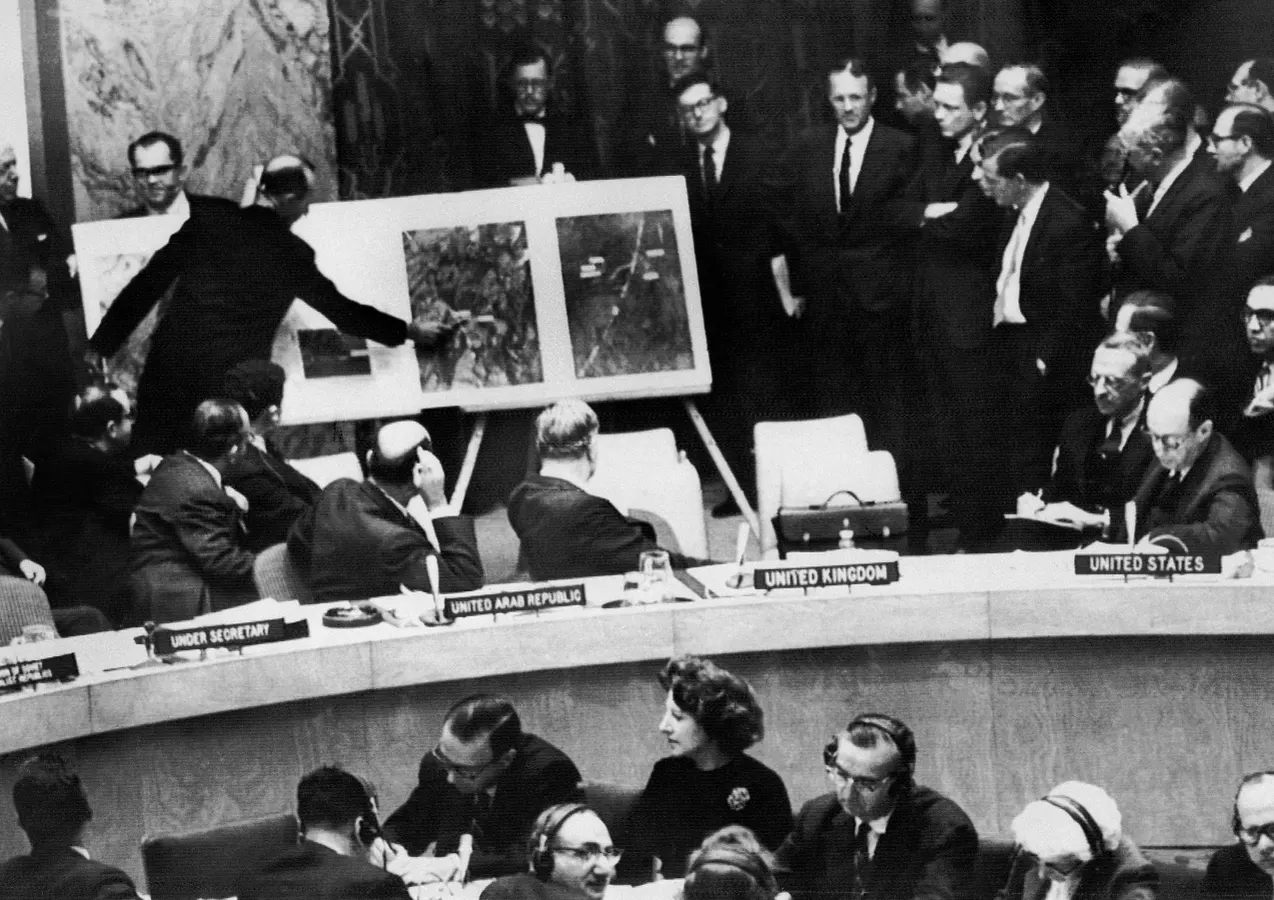Copyright forbes

An official of the Kennedy administration shows aerial views of one of the Cuban medium-range missile bases, taken in October 1962, to the members of the United Nations Security Council. (Photo by AFP) (Photo by -/AFP via Getty Images) AFP via Getty Images The Cuban Missile Crisis, which came to an end 63 years ago tomorrow, remains remarkable for several reasons. In addition to bringing the world to the brink of nuclear war, the 13-day crisis was marked by twists and turns that ended when Soviet Premier Nikita Khrushchev promised he would remove medium-range missiles from Cuba. Acting on inaccurate information about U.S. plans to invade the island nation, negotiations to end the standoff were also aided by backchannel communications between Moscow and Washington. In his book, “Bureau of Spies: The Secret Connections between Espionage and Journalism in Washington,” Steven Usdin documented the conduit role of Frank Holeman, who was then a reporter with the New York Daily News working out of its DC bureau, and a former president of the National Press Club. Holewman had important connections with a Soviet journalist who was really a spy, and another individual who was an official at the Soviet embassy. Because of these connections, the American reporters served as an unofficial messenger between the Kennedy administration and the Kremlin during the crisis. With his newspaper on strike during this critical time, Holeman was temporarily working for the president’s brother, Attorney General Robert Kennedy. He instructed Holeman to tell his contact at the Soviet embassy that “the United States could be persuaded to remove its missiles in Turkey and Italy if the Soviets removed theirs from Cuba,” Gil Klein, the National Press Club’s historian, recalled in a story on the organization’s website. Khrushchev agreed, and the crisis ended on October 28, 1962. Backchannel corporate communications Just as secret diplomacy helped avert a global catastrophe in 1962, quiet backchannel communications can play a similar—if less dramatic—role in managing business crises. In corporate crisis situations—such as a data breach, product recalls, or public controversy—confidential and private conversations could be a deciding factor in whether a brand regains control or loses the narrative. “Quiet coordination with investigators before disclosure or off-record briefings with trusted community voices can temper public outrage and create a path toward transparency. In other cases, regular dialogue behind the scenes helps shape corrective actions long before a company re-enters the spotlight,” Olya Goldenberg, vice president of public relations at Ingage Biz, told me in an email message. MORE FOR YOU Backchannel communication “is a lost art that is a powerful tool in times of crisis to maintain clarity and control of the situation before public messages take hold,” Jason Vaught, director of content and marketing at SmashBrand, told me in an email interview. Blurry interior of a grocery store aisle behind large red Recall text He’s used backchanneling with product-related issues “when a little private coordination with supply partners and/or legal groups helped to create a consensus of the facts and messages before it was discussed in public communications. It’s that kind of private conversation that helps to control the situation and does not allow for hasty, erroneous public statements that only add to the erosion of trust,” he observed. When managed transparently and ethically, backchannel communications can provide the framework that keeps a crisis from escalating. “These private, informal exchanges with regulators, partners, or media allow organizations to verify facts, align messaging, and maintain trust while public statements are being finalized,” Goldenberg commented. In Goldenberg’s experience leading crisis communications across corporate, technology, government, and real-estate sectors, “backchannels are not about concealment; they’re about control through clarity. They stabilize relationships, prevent misinformation, and ensure accuracy before narratives take hold protecting both the integrity of the message and the public’s right to an accurate account before it impacts market confidence or brand reputation,” she explained. Creating space before reacting Every word can count in a crisis—as well as when, where, and how those words are spoken or written. “In a crisis, when every word can shift perception, private channels create space to think before reacting. They allow leaders to test assumptions, clarify facts, and align internally before speaking publicly,” Nikki Jain, founder and president of The Sprout PR, told me in an email interview. But there can be risks in using backchannel communication, including leaks and the perception of secrecy or a coverup. That’s why “every private exchange should be viewed as potentially [going] public,” Jain advised. To prepare for that possibility, executives should define the terms of the backchannel conversations up front, document participants and content, involve legal counsel when appropriate, and convert private conversations into credible public statements in a timely manner. Backchannel communications “can allow for frank communication without the concern over unnecessary details to be misinterpreted in the public sphere. It provides space and a chance to educate and explain to allow the real story to be told,” Rich Went, head of client services and strategy for public relations firm Gallium Ventures, told me in an email message. He cited the example of a company that has a data breach. “The headlines from such a story can be incredibly damaging; but there are often layers of complexity to such stories, especially if there are multiple companies involved in the data handling process. Here, back-channeling can allow time for alignment and to provide a more concise final response, that allows both the media and the public to get to grips with what personal data has really been impacted and what is being done to resolve it,” Went pointed out. These behind-the-scenes communications should be used sparingly. “It should never be used to obfuscate or re-direct; not just because it won’t work in the long term, but that it can cause significant reputational damage. Increasingly, many publications and journalists are also refusing to speak on-background or off the record, largely because so many have abused these privileges in the past,” he concluded. There can be more than one way to address and resolve a crisis. Sometimes success depends on how—and where—communication takes place. As history shows, the most critical negotiations can unfold not in the public eye, but quietly, behind the scenes. That’s why business leaders could consider using backchannel communications to help resolve a crisis at their organizations. Editorial StandardsReprints & Permissions



